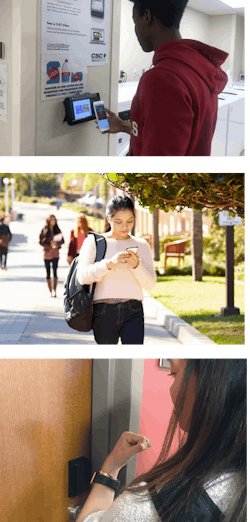This article originally appeared in the June 2022 issue of Security Business magazine. When sharing, don’t forget to mention Security Business magazine on LinkedIn and @SecBusinessMag on Twitter.
As a reputable systems integrator that customers across all vertical markets can rely on, keeping up with innovations and trends in door security is vital to strong partnerships and a strong service business. Staying current, or better yet ahead of the curve, also keeps things interesting and challenging.
In doing so, one important trend integrators should be following is that access credentials are going mobile on more and more college campuses. This presents some extraordinary opportunities; thus, it is important to have a clear understanding of the technology and the motivation behind the trend if integrators want to continue to be a valuable resource to customers exploring the benefits.
What is driving this trend? The short answer is the student experience. Mobile credentials give students the convenience and security they have so quickly become used to with Apple Wallet and Google Pay apps. Whether a campus is embracing the technology has become a deciding factor for students considering what school to attend. There is virtually nothing they would not expect to do on their mobile devices, from point-of-sale, cafeteria and vending machine purchases to safe access to residence hall rooms and more.
Mobile access at universities can simply be defined as the ability to use a mobile device with credentials togain authorized entry to the complete array of secured doors, gates, lockers, networks and services like the library, bookstore and sporting events.
While mobile solutions may not completely replace the use of physical cards and brass keys for a while, they do offer integrators a fast-growing opportunity to help schools meet demands for a mobile-first campus. It is no surprise that out of 115 university decision makers surveyed, more than 70 percent said they are already using mobile credentials or plan to in the next five years. The mobile credential revolution is also picking up steam in environments beyond higher education.
Enhanced Security, Flexibility and Accountability
Along with ease of use and the convenience of instant activation, deactivation and upgrades of credentials, mobile solutions improve security. Think how likely you are to lose or misplace your phone and not realize it. On the other hand, it is not uncommon to forget to grab a key card or worse, unwittingly drop it. A user might not even miss it for a few days, especially if it is lost over a weekend.
They are more apt to deal with a missing smartphone promptly than rush to report the loss and stand in line to replace a keycard. Phones also tend to have dual verification or a form of biometric identification. A card just needs a reader and can be used by anyone. If it falls into the wrong hands, security and access will obviously be compromised. Certain legacy card credential technologies can also be vulnerable to cloning.
Convenience and security extend to the professionals who provision credentials as well. Instead of requiring incoming students to queue up in long lines at a security or card office to get their keycards, administrators can simply activate customized credentials to the designated smartphone. That high level of remote flexibility also makes it fast and easy to authorize a visitor’s or contractor’s phone for special situations when requested.
In addition, mobile access control credentials generate detailed audit trails just as easily as keycards do to capture user accountability and measure occupancy, which can help with intelligent planning for future space requirements around campus.
While surveys show a high interest in migrating to mobile credentials, some universities are not quite ready to go all-in yet. Even so, they are still eager to create an enhanced student experience and are either currently planning or rolling out a progression of upgrades as rapidly as budgets and timelines allow. In the meantime, they are wisely future-proofing door openings by installing readers and locks that can support both card and mobile credentials. That makes it easy to migrate to mobile access when it is time to launch. The same goes for other organizations considering the solution.
Understanding Mobile Access Technologies
NFC (Near Field Communication) and BLE (Bluetooth Low Energy) are the two leading technology protocols supporting mobile access. While both are highly effective for mobile applications and offer secure communication, they have some significant differences, including where data is stored. NFC is an open standard with the credential stored in the wallet behind several layers of security. BLE is used within a self-contained app from a provider with end-to-end security built in.
NFC enables devices within a few centimeters of each other to exchange information wirelessly. With NFC, the student ID is built into Apple Wallet or Google Pay and can be used to access residence halls, libraries and event facilities or pay for laundry, merchandise and dining on campus. Originally, 100% parity was required between a card and the mobile device, to ensure that students would have the same experience with mobile as they do with a card. For example, if students can use their cards for vending, meals, and door access, they would be able to do the same with their mobile credentials. Today, schools may choose to take a phased-in approach to ease the burden of a 100% shift.
BLE enables wireless transmission of access credentials to a Bluetooth-enabled proximity reader. While most of the applications available with NFC, such as payment, can also be done with BLE, the user experience is slightly different. That’s why BLE is primarily focused on door access control. The technology requires a third-party app, which can be built into the campus app. That app must be open to use the mobile credential. Smartphones can handle both NFC and BLE.
The Cost-to-Benefit Ratio
Understandably, cost can impact the speed of adoption. Campuses are also weighing the costs of implementing mobile against the potential loss of revenue that they have grown accustomed to receiving from issuing card credentials. For instance, an initial card might cost a student $30 and $20 for a replacement. That is revenue from card production that historically helped fund a card office employee.As a counterbalance, some universities are incorporating mobile activation into their student technology fees to cover things like printing kiosks, department-specific tools and credential packages that accommodate a mix of smartphones, physical cards, and wearables (watches, rings and future devices). The biggest influence tipping the scale, though, is the value gained from providing the mobile experience that students are demanding along with its improved security, efficiency, and marketability for recruiting. Administrators are also noting increased interest beyond the student body.
Best Practices for Planning and Implementation
The move to mobile access is an exciting journey for colleges and universities that will impact the way students, faculty and staff live their lives on campus. As a trusted partner, integrators have the opportunity to be vital to its success.
Whether a school is going for 100% parity or taking a phased-in approach, integrators can impress on them how essential it is to have a clear roadmap for going mobile. The sooner planning can start and the sooner the integrator and vendors get involved, the clearer the path will be toward identifying specific needs and timelines and determining the right solutions, products and installation strategy to meet them.
There are many factors to consider when evaluating costs. A skilled integrator can offer the expertise needed for conducting a thorough analysis that compares total system costs. Universities will be looking for additional guidance on continuously evolving credential technologies – including access control locks and readers that can support their current and future plans as well as emerging innovations.
Integrators and their vendor partners have been instrumental in successful installations at a variety of major higher education institutions. Case in point: ASSA ABLOY and its integration partners were involved in the first Apple mobile access deployments in the world at the University of Alabama, Duke University and the University of Oklahoma. Bringing the vendor into the conversation early can help with technological know-how, clarity and support that helps keep significant projects and investments like this moving forward smoothly and operating reliably.
Getting proactively involved as partners also applies to other potential mobile access markets. While higher education is certainly leading the way in adopting mobile credentials, commercial real estate, corporate offices and healthcare facilities are embracing the trend as well. This presents even more exciting opportunities for integrators to position themselves as an expert resource as customers explore the potential benefits of the growing mobile credential revolution.
Jeremy Saline is the senior director of business development for ASSA ABLOY Opening Solutions. For further information, check out the eBook, “Demystifying Mobile Access on Campus” at https://pages.intelligentopenings.com/mobile-access-ebook or request more info about the company at www.securityinfowatch.com/10212899.





